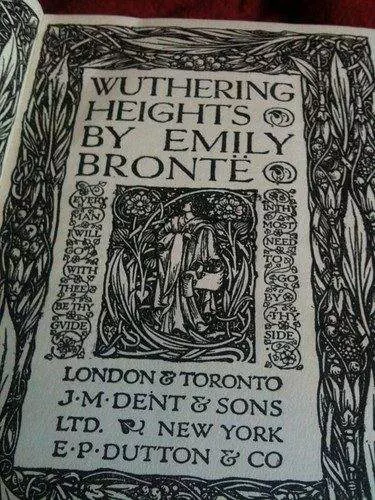Published in 1847 under the pseudonym Ellis Bell, Wuthering Heights is the only novel written by Emily Brontë. A haunting story of all-consuming love, destructive obsession and revenge, it centers around the tumultuous relationship between the brooding Heathcliff and beautiful Catherine Earnshaw. Set on the bleak Yorkshire moors, this gothic romance novel introduced wild, primitive passions into English literature and remains one of the most studied, adapted and acclaimed classics.
Table of Contents
Plot Summary
Narrated through flashbacks, the story begins with Mr. Lockwood renting the remote estate Thrushcross Grange. He visits his unfriendly landlord Heathcliff at nearby Wuthering Heights and finds the household strange and inhospitable. Snowed in, Lockwood has nightmares of the ghostly Catherine begging to be let in through the window.
Intrigued, he coaxes housekeeper Nelly Dean into revealing Wuthering Heights’ tragic history. She recounts how Catherine and Heathcliff were raised together, developing an intense inseparable bond. But Catherine marries her wealthy neighbor Edgar Linton which devastates Heathcliff, who later returns transformed, wealthy and determined to gain revenge on those who wronged him.
Themes and Analysis
Key themes and ideas depicted in this novel:
- Destructive power of obsessive love, jealousy and rage
- Social class divides and economic disparity
- Abuse and dysfunctional family dynamics
- Contrast between wild uncivilized nature and genteel nurture
- Supernatural aura, ghosts as reflections of past trauma
- Cycle of generational violence spawned from unresolved heartbreak

Brontë brought haunting gothic elements into romantic fiction. She examines class conflicts and gender roles in 19th century England through the microcosm of two estates and families bound by complex histories.
The remote Yorkshire moors act as backdrop reflecting the wild spirit of the characters. Through fragmented narration and time shifts, Emily Brontë created a disturbing psychological drama that still feels strikingly modern.
The Brontës and Romanticism
Born in 1818, Emily Brontë was part of the creative Bronte family in Yorkshire along with her sisters Charlotte and Anne. The isolated moors shaped the fantasy worlds they created through writing growing up. Their novels reflected individualism and emotions influenced by Romanticism.
Key historical context:
- The Romantic literary movement valuing emotion, nature and imagination
- Growing industrialization in England yet remote rural areas persisted
- Rigid Victorian morality and Christian values coexisting with hidden passions
- Strict gender roles maintained in patriarchal society
- Gothic genre exploring dark emotions through supernatural tales
- Colonial expansion linking England to distant locales like Asia
Emily Brontë died shortly after Wuthering Heights was published to mixed reviews. She brought forbidden anti-heroes and open expressions of desire into the Victorian literary scene.
Analysis of Characters
Heathcliff – Adopted as a boy by the Earnshaws, his obsessive love for Catherine and desire for vengeance drive the story. A dark, gothic antihero.
Catherine Earnshaw – The wild, beautiful daughter of Wuthering Heights who shares a deep bond with Heathcliff but marries Edgar Linton. Her ghost haunts the moors.
Edgar Linton – Catherine’s kind, refined husband from Thrushcross Grange who represents social propriety and gentility. The opposite of Heathcliff.
Hareton Earnshaw – The son of Hindley and last heir of Wuthering Heights who is raised by Heathcliff into an uneducated servant.
Isabella Linton – Edgar’s naive sister who elopes with Heathcliff but suffers abuse. She contrasts the more defiant Catherine.
Mr. Lockwood – The new tenant of Thrushcross Grange and outsider through whose eyes the turbulent history of the Earnshaws and Lintons unfolds.
Read This Too: Pride and Prejudice – Jane Austen’s Beloved Comedy of Manners
Influence and Significance
As an seminal gothic romance, Wuthering Heights has exerted vast literary influence:
- Introduced gothic supernatural elements into romantic fiction.
- Heathcliff became the archetype of the dark, brooding antihero and “Byronic hero”.
- Depicted open raw passion and destructive aspects of love pioneering modern psychological romance.
- Use of fractured narration and shifting timelines became common.
- Inspired “anti-novels” that broke conventions with amoral characters and unhappy endings.
- Cathy and Heathcliff as embedded cultural symbols of doomed lovers kept apart by class.
- Evocative Yorkshire moors became a seminal literary and film setting.
- It liberated expressions of feminine desire and complexity of female characters in fiction.
- Critics appalled by its violence and darkness but success proved demand for dramatic psychological fiction.
Why Read Wuthering Heights
There are many reasons why Wuthering Heights is considered a masterpiece:
- Emily Brontë’s poetic prose and gothic imagination craft an unforgettable atmosphere.
- Cathy and Heathcliff’s star-crossed love story remains one of literature’s most tragic romances.
- The cycle of generational revenge, abuse and class tension makes for riveting drama.
- The glimpses of lesbian desire between Cathy and Nelly Dean were pioneering.
- Heathcliff stands out as the ultimate antihero and brooding male lover.
- The stark contrast between Thrushcross Grange and Wuthering Heights highlights class divides.
- The haunted, foreboding Yorkshire moors acts as the perfect gothic backdrop.
- It introduced raw human emotions and rebellious passions into Victorian fiction.
- The nonlinear narrative structure and frame narrative were innovative.
- Its unflinching portrayal of dysfunctional families and relationships remains relevant.
Conclusion
Daringly original and hauntingly lyrical, Emily Brontë’s only novel gave voice to repressed female desire and revolutionary passions in Victorian England. Populated by uniquely flawed lovers, ingenious outsiders and vengeful outcasts, Wuthering Heights remains a quintessential gothic masterpiece of love, grief and the supernatural. Over 170 years later, Cathy and Heathcliff continue to roam the moors as two of literature’s most eternal lovers ever separated in life but united in death.



1 Comment
Pingback: Anne Brontë's Agnes Grey: The Realism That Shocked Victorian Readers - LitGram by MukeshRishit